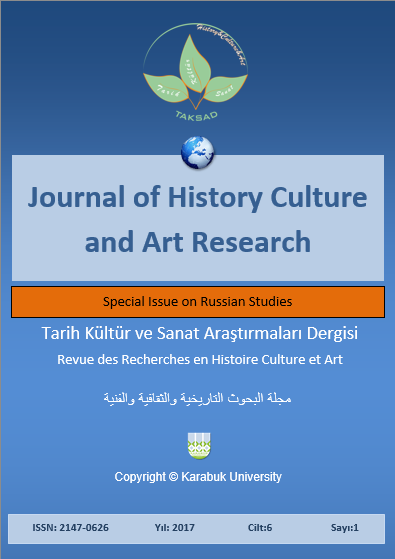Spanish Renaissance High Culture in Soviet Historiography: Interdisciplinary Aspect
DOI:
https://doi.org/10.7596/taksad.v6i5.1257Keywords:
History, Spanish renaissance, Russia, Historiography, World cultural heritage, History of theatre, Soviet era, Interdisciplinarity.Abstract
The tradition of studying Spanish Renaissance in Russia is quite a complicated phenomenon, which requires a detailed analysis. The main questions which arise when referring to the issue are those of developmental patterns and interdisciplinary aspect of the letter. Spanish Renaissance culture is traditionally the subject to scrutiny for historians, philologists and art historians. The present article aims to outline a preliminary picture of interdisciplinary interaction, which gained momentum in the Soviet period of Russian Hispanism. Special attention is paid to the imminent figures of Spanish Renaissance historiography, as well as their ideas and concepts. The evolution of Spanish Renaissance studies is described against the background of the principal research areas. The present paper will be of interest to both intellectual historians and scholars investigating Renaissance and medieval history.
References
Antonova, N. V. (2016). Spanish Renaissance art and mentality in Russian historiography (from the origins to the present day). International Journal of Humanities and Cultural Studies, July 2016, 231-237.
Antonova, N. V.; Zaitsev, A. A. & Zagladina, E. N. (2016). Origins of "Black legend" about Philip II in the works of modern European and American Hispanists. Historical, philosophical, political, juridical cultural and artistic studies. Theoretical and practical issues, 4(1), 17-20, Tambov: Gramota.
Bagno, V. E. (2001). Hispanismo en Rusia y en los Países del Este: Adonde va, de dónde viene. Arbor CLXVIII, 664, 609-621.
Bakhtin, M. M. (1965). Oeuvre of Rabelais and the Popular Medieval and Renaissance Culture. Moscow: Chudozhestvennaya literatura.
Botkin, V. P. (1976). Letters on Spain. Leningrad: Nauka.
Derzhavin, K. N. (1958). Cervantes: Life and Creativity. Moscow: Goslitizdat.
Kaptereva, T. P. (1989). Spanish art: Essays. Moscow: Izobrazitelnoye iskusstvo.
Kluev, A. I. & Sveshnikov, A. V. (2013). The Main Approaches to the History of Russian medieval studies. Annals of Omsk University, 3, 57-62.
Krikh, S. B. (2014). The Language of Soviet Historiography: A Preliminary Sketch. Uchenye Zapiski Kazanskogo Universiteta. Seriya Gumanitarnye Nauki, 156(3), 214-222.
Kudriavtsev, A. E. (1937). Spain in Middle Ages. Leningrad: Sotsekgiz.
Levina, I. M. (1966). Spanish art in the XVI-XVII centuries. Moscow: Iskusstvo.
Lysenko, E. M. (2002). A Short Biographical Sketch. Pinsky L.E. Renaissance. Baroque. Enlightenment: Articles. Lectures, pp. 5-24. Moscow: Russian State University for the Humanities.
Malitskaya, K. M. (1968). Toledo: the old capital of Spain. Moscow: Iskusstvo.
Mokulsky, S. S. (1953). Introduction. Reader on the History of Western European Theatre (2nd ed.), in 2 volumes, Vol. 1., pp. 3-31. Leningrad: Iskusstvo.
Mokulsky, S. S. (1956). History of the Western European Theatre. In 8 Volumes, Vol. 1. Moscow: Iskusstvo.
Morozova, A. V. (2013). Tatiana Petrovna Kaptereva, the Great Russian Hispanist. Spanish Themes and Forms: Art, Culture and So: International Scientific conference society, pp. 11-12. Saint Petersburg: St. Petersburg University.
Morozova, A. V. & Malitskaya, K. M. (2011). Local Spanish art historians (1890-1969). Annals of St. Petersburg University, 2(1), 107-115.
Pichugina, I. S. (1958). Investigating of Medieval Spain in Soviet historiography. Middle Ages, 13, 69-78.
Pinskiy, L. E. (1937). Renaissance and Baroque. In D. Arkin & B. Ternovets (eds.), The Art Masters about the art, in 4 Volumes, Vol. 1, pp. 11-39. Leningrad: Isogiz.
Pinskiy, L. E. (1961). The Renaissance Realism. Moscow: Goslitizdat.
Piskorskiy, V. K. (1902). Spain and Portugal History. Saint Petersburg: Brockhaus-Efron.
Repina, L. P. (2014). Ideas and people. Intellectual European culture in the Modern Period. Moscow: Akvilon.
Repina, L. P. & Myagkov, G. P. (2014). Intellectual culture and academic communications. Vestnik Udmurtskogo universiteta, 3, 137-142.
Shtein, A. L. (1976). History of Medieval Spanish Literature: Middle Ages and Renaissance. Moscow: Vysshaya shkola.
Smirnov, A. A. (1969). Medieval Spanish Literature. Leningrad: Nauka.
Sychenkova, L. A. (2015). History of West European culture in Russian cultural studies. Kazan: Kazan University press.
Sychenkova, L. A. (2016). Overcoming the Barrier of "Emigre Periphery": P.M. Bicilli in European Medievalism. Uchenye Zapiski Kazanskogo Universiteta. Seriya Gumanitarnye Nauki, 158(3), 829-839.
Uzin, V. S. (1930). Spain Literature. Literary Encyclopedia, vol. 4. Moscow: Izdatelstvo Kommunisticheskoy Academii.
Vedyushkin, V. A. (2011). Spanish Renaissance in the works by Russian scholars. Electronic academic journal History, 2(8). URL: http://history.jes.su/s207987840000242-5-1.
Downloads
Published
How to Cite
Issue
Section
License
All papers licensed under Creative Commons 4.0 CC-BY.- Share — copy and redistribute the material in any medium or format
- Adapt — remix, transform, and build upon the material for any purpose, even commercially.
Under the following terms:
Attribution — You must give appropriate credit, provide a link to the license, and indicate if changes were made. You may do so in any reasonable manner, but not in any way that suggests the licensor endorses you or your use.
- No additional restrictions — You may not apply legal terms or technological measures that legally restrict others from doing anything the license permits.







